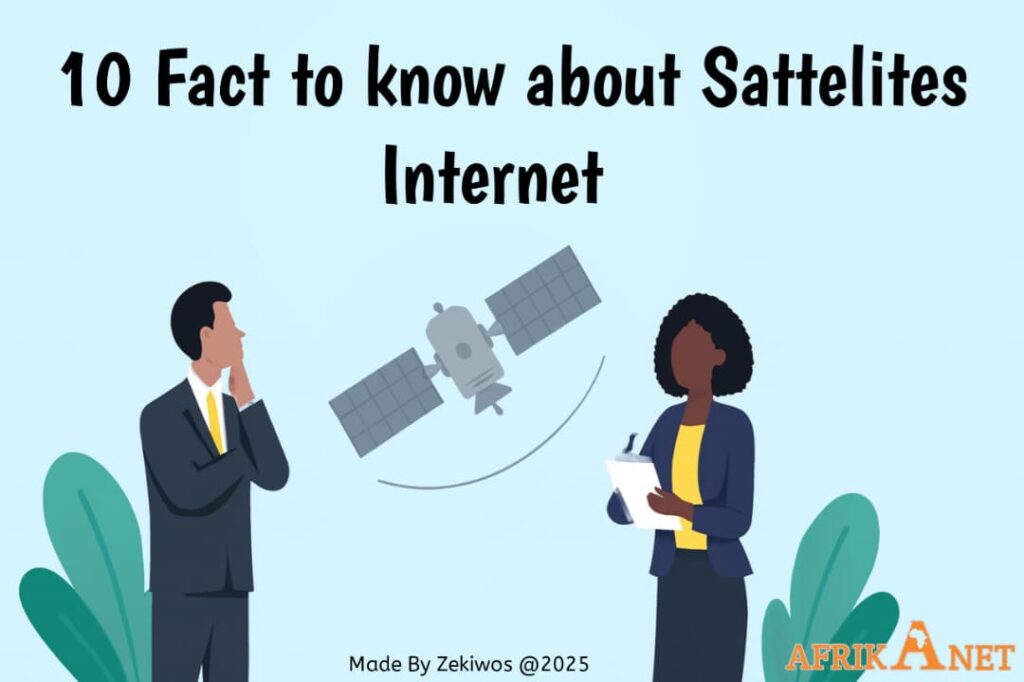--------------------------------------------------------------------------------
10 Fact to know about Sattelites Internet
1. A Single Satellite Can Cover an Entire Continent
Satellites orbiting at 35,786 kilometers above Earth — known as geostationary orbit — rotate at the exact same speed as the planet. This allows them to “hover” over one location, providing a constant connection to huge regions below. A single geostationary satellite can cover an entire continent like Africa with its signal footprint. That’s why, before terrestrial fiber networks expanded, many rural African towns first got online using satellite dishes that connected directly to these orbiting giants — offering connectivity where cables could never reach.
2. LEO Satellites “Hand You Off” Like Cell Towers
Low Earth Orbit (LEO) satellites fly much closer — around 550 to 1,200 kilometers above Earth — so they move across the sky quickly, completing a full orbit every 90 minutes. Because of this, your internet connection doesn’t stay with just one satellite. Instead, your receiver is constantly switching (or “handing off”) to the next satellite passing overhead. This handoff happens seamlessly, similar to how your phone moves between cell towers, allowing you to stay online even when the satellite you were using has already crossed the horizon.
3. LEO Satellites Communicate with Each Other in Space
Unlike older satellite systems that sent all data back to Earth after each hop, modern constellations like Starlink, OneWeb, and Amazon Kuiper feature laser inter-satellite links. These are space-based laser communication systems that allow satellites to send data directly to one another without relying on ground stations. The result? Your message can travel halfway across the world entirely through space, bouncing between satellites at nearly the speed of light. This reduces latency dramatically — in some cases, faster than undersea fiber cables — and enables connectivity even in the most remote oceanic or desert regions.
4. Each Satellite Has a “Spot Beam” Network
Instead of covering huge areas with a single, weak broadcast, satellites use hundreds of tightly focused spot beams that deliver stronger, more efficient signals to specific regions. Think of them like invisible “Wi-Fi zones” in the sky, each covering a small patch of land or sea. These spot beams can also be redirected or “reused” across the planet, meaning a satellite can concentrate extra bandwidth over areas of high demand — like during a natural disaster, a live event, or a population surge in a city.
5. The Antennas Aren’t Round Dishes Anymore
Gone are the days of bulky parabolic dishes bolted to rooftops. Modern satellite internet uses phased-array antennas — sleek, flat panels that electronically steer their beams to follow satellites across the sky. They have no moving parts and can track multiple satellites at once, making them perfect for vehicles, aircraft, or ships constantly in motion. These smart antennas are part of what makes LEO networks so powerful — they allow constant high-speed connectivity even while you’re driving, flying, or sailing.
6. Data Travels 20,000 Miles in a Fraction of a Second
When you click on a video or load a webpage through satellite internet, your signal doesn’t just travel across a city — it travels across space. It goes from your antenna to a satellite thousands of kilometers above Earth, then back down to a ground station connected to the global internet. In total, your data might travel over 20,000 miles round-trip — yet all of this happens in just milliseconds. Thanks to advancements in LEO constellations, that delay (latency) has dropped from around 600 ms with old GEO satellites to as low as 25–40 ms today, making real-time video calls and gaming possible even over space connections.
7. Satellites Can Beam Internet to Airplanes and Ships
For aircraft and maritime industries, satellite internet is a lifeline. High-altitude beams are specifically designed to connect moving targets — like passenger planes flying over the Sahara or cargo ships crossing the Indian Ocean — where no terrestrial infrastructure exists. Some modern aircraft now offer passengers Wi-Fi speeds exceeding 100 Mbps, powered entirely by orbiting satellites. This same technology is being adapted to connect rural schools, remote hospitals, and even solar-powered drones staying airborne for months at a time.
8. Each Satellite Has a Limited “Life Span”
Satellites are not permanent — they have a limited supply of fuel used for maintaining their orbit and correcting small drifts caused by gravity and solar radiation. Most communication satellites have operational lifespans between 5 and 15 years, depending on their orbit and propulsion system. Once they run out of fuel or power, they’re either moved to a higher “graveyard orbit” (for GEO satellites) or intentionally deorbited to burn up safely in Earth’s atmosphere. This controlled process prevents space debris and keeps orbits clear for new, more advanced replacements.
9. Africa’s Connectivity Is Linked to Space “Gateways”
Even though satellites orbit directly over Africa, internet data must still flow through ground gateway stations that connect the space network to the terrestrial fiber backbone. These gateways are located strategically — often in countries like South Africa, Kenya, and Nigeria, or even outside Africa in Europe. From there, data joins the global internet routes. This hybrid approach — space-to-ground-to-fiber — is what makes large-scale satellite connectivity efficient and scalable for millions of users across the continent.
10. Future Satellites Will Be AI-Controlled
The next generation of communication satellites is being designed with artificial intelligence onboard. These smart satellites will dynamically reroute signals, predict congestion, and optimize coverage in real time without human intervention. For example, if one region’s network suddenly spikes in usage (like during a live sports event or emergency), AI algorithms will automatically shift bandwidth from less busy areas to maintain smooth connectivity. This evolution marks the future of satellite internet — where space networks think, adapt, and respond on their own.

